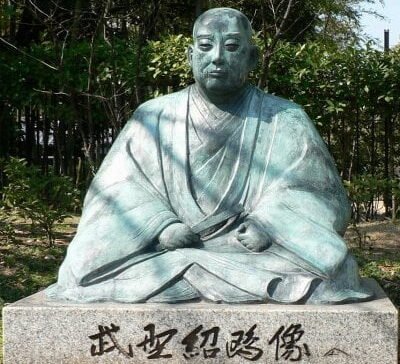Contents
ToggleIn short
Sen no Rikyū (1522 – 1591), also known simply as Rikyū, is considered the historical figure with the most profound influence on chanoyu, the “Way of Tea.” Japanese, particularly the tradition of wabi-cha. He was also the first to emphasize several key aspects of the ceremony, including rustic simplicity, directness of approach, and self-honesty.

Sen no Rikyū, the art of tea
Rikyū was born in Sakai in present-day Osaka Prefecture. His father was a warehouse owner named Tanaka Yohei, who later in life also used the surname Sen, and his mother was Gesshin Myōchin. His childhood name was Yoshiro (與四郎).
As a young man, Rikyū studied tea under the Sakai townsman Kitamuki Dōchin (1504–1562), and at the age of nineteen, through Dōchin's introduction, he began studying tea under Takeno Jōō, who is also associated with the development of the wabi aesthetic in the tea ceremony. He is believed to have received the Buddhist name Sōeki from the Rinzai Zen priest Dairin Sōtō of Nanshūji Temple in Sakai. He married a woman known as Hōshin Myōju around the age of twenty-one. Rikyū also underwent Zen training at Daitoku-ji Temple in Kyoto. Not much is known of his middle years.
In 1579, at the age of 58, Rikyū became tea master for Oda Nobunaga, and after Nobunaga's death in 1582, he became tea master for Toyotomi Hideyoshi. His relationship with Hideyoshi quickly deepened, and he entered Hideyoshi's circle of confidants, becoming the most influential figure in the chanoyu world.
In 1585, because he needed additional credentials to enter the Imperial Palace so that he could assist at a tea gathering that would be given by Hideyoshi for Emperor Ōgimachi and held at the Imperial Palace, the Emperor granted him the Buddhist lay name and title "Rikyū Koji" (利休居士). Another major chanoyu event of Hideyoshi's in which Rikyū played a central role was the Great Kitano Tea Ceremony, held by Hideyoshi at the Kitano Tenman-gū in 1587.
It was in his later years that Rikyū began to use very small, rustic teahouses called sō-an ("grass hermitage"), such as the two-tatami teahouse called Tai-an, which can be seen today at Myōki-a temple in Yamazaki, a suburb of Kyoto, and which is credited with his design. This teahouse has been designated a National Treasure. He also developed many tea ceremony implements, including bamboo flower vessels, tea spoons, and lid rests, and also used everyday objects for the tea ceremony, often in novel ways.
Raku tea bowls were born from his collaboration with a tiler named Raku Chōjirō. Rikyū had a preference for simple, rustic items made in Japan, rather than expensive items made in China that were fashionable at the time. Although he was not the inventor of the philosophy of wabi-sabi, which finds beauty in the very simple, Rikyū is one of the main people responsible for its popularization, development and incorporation into the tea ceremony. He created a new form of tea ceremony using very simple instruments and surroundings.
This and his other beliefs and teachings are known as sōan-cha (the thatched hermitage style of chanoyu), or more generally, wabi-cha. This lineage of chanoyu that his descendants and followers continued was recognized as Senke-ryū.
A writer and poet, the tea master referred to tableware and its relationship to the tea ceremony by saying, “Although you wipe your hands and remove the dust and dirt from the vessels, what is the use of all this fuss if the heart is still impure?”
Although Rikyū was one of Hideyoshi's closest confidants, due to crucial differences of opinion and because he was too independent, Hideyoshi ordered him to commit ritual suicide. A year earlier after the Siege of Odawara (1590), his famous disciple Yamanoue Sōji was tortured and beheaded on Hideyoshi's orders. Although Hideyoshi's reason for doing so is never known for certain, it is known that Rikyū committed seppuku at his residence in Hideyoshi's Jurakudai villa in Kyoto in 1591 on the 28th day of the 2nd month (of the traditional Japanese lunar calendar; or April 21 when calculated according to the modern Gregorian calendar), at the age of seventy.
According to Okakura Kakuzō in The Book of Tea, Rikyū's final act was to hold an exquisite tea ceremony. After serving all his guests, he presented each piece of tea equipment for their inspection, along with an exquisite kakemono, which Okakura described as "a wonderful writing by an ancient monk dealing with the evanescence of all things."
Rikyū presented each of his guests with a piece of the equipment as a souvenir, except for the bowl, which he broke, uttering the words: "Never again shall this cup, polluted by the lips of misfortune, be used by man." As the guests departed, one remained to serve as a witness to Rikyū's death. Rikyū's last words, which he wrote as a death poem, were in verse, addressed to the dagger with which he committed suicide:
Welcome to you,
O sword of eternity!
Through Buddha
And through Daruma likewise
You split your path.
When Hideyoshi built his lavish residence in Fushimi the following year, he noted that he wanted its construction and decoration to please Rikyū. Hideyoshi was known for his temper and reportedly expressed regret for his treatment of Rikyū.
Rikyū's grave is located at Jukōin Temple within the grounds of Daitoku-ji in Kyoto; his posthumous Buddhist name is Fushin'an Rikyū Sōeki Koji.
Memorials for Rikyū are observed each year by many tea ceremony schools. japanese. The annual memorial service of the Omotesenke school is held at the family seat every year on March 27, and that of the Urasenke school is held at the seat of one's own family every year on March 28. The three Sen families (Omotesenke, Urasenke, Mushakōjisenke) take turns holding a memorial service on the 28th of each month, at their joint family temple, the Jukōin subsidiary temple at Daitoku-ji Temple.
Social networks
Today, the Japanese pay homage to the tea master of the Wabi school, Sen no Rikyū. He became a monk at Daitoku-ji temple and a specialist in chanoyu, the Japanese tea ceremony. He enters the service of Oda Nobunaga before being forced to commit suicide by seppuku. #mythology #myth #legend #calendar #japan #tea #March 28
Picture
